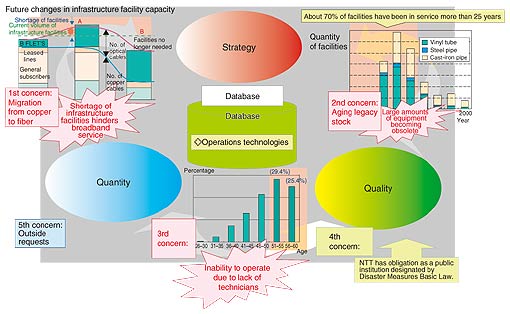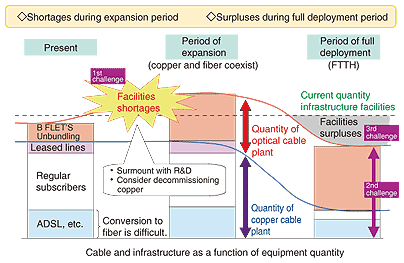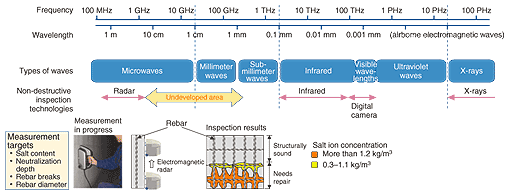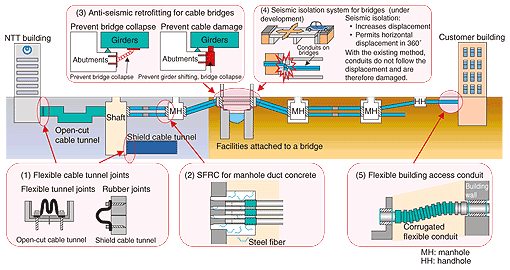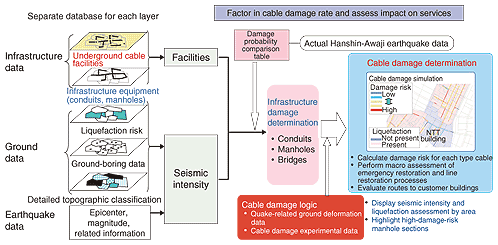 |
|||
|
|
|||
|
Special Feature: NTT Tsukuba Forum 2006 Workshop Lectures Vol. 5, No. 5, pp. 20–27, May 2007. https://doi.org/10.53829/ntr200705sf3  Infrastructure Equipment Management Technology for the Optical AgeAbstractNTT's telecommunications infrastructure equipment is in urgent need of upgrading before the full-scale deployment of optical fiber in residential networks. Some facilities are obsolete, many issues still need to be addressed, and, in their current state, the infrastructure facilities cannot support NTT's ambitious plan to extend fiber access to 30 million households by the end of FY2010. Here, I discuss five basic concerns related to infrastructure equipment and survey some of the research and development now under way to address these issues.
1. Broadband service trendsDSL (digital subscriber line) access, which accounted for some 63% of broadband service connections in Japan (as of March 2006) after showing slight incremental gains for some time, fell slightly for the first time in 2006. Meanwhile, the number of CATV(cable TV) Internet subscriptions remained static at 14% of the market. Only fiber-to-the-home (FTTH)—with 23% of broadband connections in March 2006—is showing rapid sustained growth, and subscriptions are projected to surpass DSL sometime in the next few years. The main factor fueling demand for broadband infrastructure is the Internet. The "2005 Communications Usage Trend Survey" by the Ministry of Internal Affairs and Communications (MIC) reveals that by the end of 2005 there were close to 85 million Internet users in Japan, which is approximately 67% of the population. Significantly, the penetration rate is even higher, at over 90% of the population, for people between the ages of 13 and 49. Although the period of rapid growth in Internet subscriptions has given way to a period of more moderate growth, the volume of traffic continues to multiply every year, and we are seeing a trend toward much greater diversity in the objectives that people have for using the Internet. Looking at the number of telephone subscribers, we see that the mobile phone market (including mobile phone and PHS (personal handy-phone system) services) was already saturated at the end of March 2006 at 96.48 million handsets, while the number of fixed-line phones (including subscriber phones and ISDN lines) has been declining for some time and stood at around 58.08 million phones. Only IP (Internet protocol) telephony is on an upward trend, with 11.46 million subscribers in March 2006. Most observers agree that the widespread availability of FTTH will further accelerate the migration from fixed-line telephony to IP-based telephony. NTT leads the world in implementing optical fiber access systems and plans to replace fixed-line telephony with IP telephony and roll out a full range of services by leveraging the power of fiber-based broadband—ultrafast throughput and bidirectional transmission. It has committed itself to an ambitious plan to extend fiber to 30 million households by the year 2010. Currently, about 6 million subscribers are receiving FTTH services, but once ADSL subscribers begin to upgrade to FTTH, this will greatly accelerate the approach toward NTT's target. 2. Optical access (FTTH) technology trends2.1 Classification and change in optical access schemesThere are three basic types of optical access systems: single star (SS), passive double star (PDS), and active double star (ADS). The single-star topology is a 1-to-1 configuration in which a separate fiber is extended from the central office to each residential customer. The passive double-star topology uses an optical coupler at the central office and optical couplers near the customers' premises, such as on utility poles, to split the fiber. This 1-to-n topology has the advantage of requiring less hardware to support it. Finally, the active double-star topology extends fiber from the central office to a remote terminal at the curb, and a copper line continues from there to the subscriber's residence. Because the ADS topology stops short of extending fiber all the way the home, the SS and PDS topologies are specified for FTTH deployments. In providing its B FLET's optical services to customers, NTT uses a media converter (MC) and the SS topology for business subscribers and a passive optical network (PON) and the PDS topology for residential subscribers. NTT continues to increase the capacity and speed of its optical access systems year after year. Current MC and PON systems support optical services at throughputs of up to 1 Gbit/s, but work is in progress on a next-generation fiber access system that will support even faster speeds. 2.2 Optical access networks: R&D objectivesTo support NTT's mid-term strategic goal of extending fiber to 30 million households by 2010, research and development on optical access networks will be pursued in the following phases. (1) Rapid response in the short term Considerable infrastructure equipment must be put in place before the era of full-scale fiber-based services in 2010, and this demands a rapid response. Utilizing a plug-and-play approach, we are now working on a residential fiber installation system that is so simple that homeowners can easily set it up themselves and a very simple local loop installation system based on a modular approach. (2) Development after the 30 million mark is reached After the milestone of 30 million fiber connection is reached in 2010, the maintenance and operation of the large amounts of optical support equipment will be critical. We must develop technologies that reduce operating costs in dealing with service orders, removing obstacles, and replacing failed equipment (reduction of lifetime costs), while radically improving work procedures by leveraging information technology (paradigm shift). (3) Intermediate and longer-term development Looking further out on the horizon, we are exploring areas of research and development paving the way for innovative new technologies. 3. Current status of telecommunications infrastructure facilities and R&D concerns3.1 Infrastructure facilitiesNTT's services are provided over an extensive network of above-ground and below-ground telecommunications facilities that extend nationwide. The current stock of basic infrastructure facilities as of March 2006 can be summarized as follows:
3.2 Five basic concerns and R&D themes3.2.1 Five basic concernsHere, I will highlight five priority concerns that must be addressed in order to effectively manage and operate the enormous number of infrastructure facilities supporting optical networks (Fig. 1).
1) Migration from copper to fiber: Once optical services become fully available and large-scale migration from copper to fiber begins, there will be a transition period when copper and fiber coexist. During this period, efforts must be made to ensure there are no shortages of infrastructure facilities and no problems obstructing the provisioning of services. 2) Aging existing stock: As legacy equipment becomes obsolete and is taken out of service, new facilities must be built in its place to support the same level of circuit usage. Capabilities to determine the degree of deterioration and whether problems can be overcome through retrofitting and repairs are extremely important. 3) Shortage of trained personnel: Much like legacy equipment, the workforce is also growing older, and more than half the company's 1900 technicians qualified to work on infrastructure facilities are over the age of 50. We need to come up with solutions to ensure that operations are not hindered by a shortage of trained technicians. 4) NTT's public obligations: NTT is a designated public institution under the terms of Japan's "Disaster Measures Basic Law" with special telecommunications-related obligations in the event of disasters. These include improving system reliability, ensuring that critical communication lines will remain operable, and achieving prompt recovery of telecommunications services. 5) Outside requests: The Ministry of Land, Infrastructure and Transport (MLIT) is working to eliminate utility poles to improve the safety and aesthetic quality of traffic spaces. As the primary custodian of utility poles and telephone wires in Japan, we are obligated to cooperate with such requests. 3.2.2 R&D themesNext, I will consider development work that must be done to deal with these concerns, focusing on the areas of strategy, quality, quantity, and databases. 1) Strategy: asset management, configuration of infrastructure facilities network for optical age, and lifecycle cost (LCC) assessment 2) Quality: better inspection/diagnosis, repair/reinforcement using new materials, and upgrading of disaster countermeasures 3) Quantity: technologies for increasing fiber count in cable, solutions using less equipment, effective use of legacy stock, and technologies for eliminating utility poles 4) Databases: operations technologies The next section introduces some representative projects in each category. 4. Overview of telecommunications infrastructure facilities R&D technologies4.1 Technologies for configuring infrastructure facilities networks for the optical age4.1.1 Estimating demand for facilities by simulationThe period of initial optical service expansion will be a transition period in which copper and fiber plant coexist (Fig. 2). NTT's conduits are currently 60% full, but there is concern that temporary shortages may occur during the transitional period. There is also concern that, once the period of widespread penetration of FTTH connections arrives, there will be too much capacity.
To obtain an accurate picture of the optimum volume of facilities needed during the initial period of optical service expansion, we conducted simulations to estimate the demand for fiber plant and other infrastructure facilities. In selecting service areas for the simulation, we divided 16 blocks into segments based on the usage of optical and other infrastructure facilities. We then classified all NTT's central offices in terms of municipal scale (A: serves entire area, B: serves entire area/select areas, C: serves select areas, D: does not serve, and E: does not serve). Focusing on 56 buildings in type A, B, and C municipalities, we estimated future demand for facilities (taking the number of fibers as the parameter) as follows: 1) Calculated extra needs: required capacity (fiber count) - existing capacity (fiber count) = required increased capacity (fiber count) (a) 2) Calculated fiber capacity: added up the total empty space in conduits (conduit capacity) and calculated the available conduit space (fiber count) (b) 3) Calculated the need to upgrade facilities: (a) - (b) = capacity shortfall (fiber count) 4) Calculated investment requirements: Followed steps 1) through 3) and calculated required investment. The simulations revealed a number of significant results.
4.1.2 Comprehensive study covering lines, access equipment, and infrastructureBased on these results, we conducted a sensitivity analysis on specific buildings focusing on (a) conduit repair and reinforcement, (b) development of new wiring methods, (c) deterioration of copper cable, and (d) development of high-density cable. Toward the end of 2006, we developed a plan and optimum measures for reducing adverse effects on infrastructure facilities. The study was not just confined to basic infrastructure facilities, but covered the entire access equipment setup including incoming lines and access equipment. Once the era of widespread penetration of optical services actually arrives, we must address other challenges. For operating equipment, we must reassess the ground design of infrastructure facilities, create cost-effective repair plans (LCC assessment technology), and develop quality diagnosis technologies (non-destructive testing methods). To deal with surplus equipment, we must develop ways to scale back equipment and use equipment more effectively. 4.2 LCC assessment technology4.2.1 State of conduitsClose to 50% of NTT's conduit facilities have been in service for more than 30 years. More than half of these older conduits are made of steel or cast iron, which raises concern about their obsolescence. Examining the primary reasons that different types of conduits fail, we found the following. 1) Cast iron pipe: Rust is observed covering both inside and outside surfaces. Correlated with buried environment. 2) Jute covered steel pipe: Inner surfaces are rusted, while outer surfaces are pitted. No correlation with type of soil or aging. 3) Polyethylene coated steel pipe: Inner surfaces are rusted, but less deterioration occurs over time than with SA conduit. 4) Vinyl pipe: Little age deterioration is observed. Failures are mainly caused by external factors. Thus, different kinds of conduits exhibit very different performance and aging characteristics. We must take these different deterioration characteristics into account. 4.2.2 State of manholesRoughly 60% of the manholes in Japan were constructed over 30 years ago. While these are concrete structures that one might expect to be somewhat impervious to deterioration, an increasing number are showing cracks, separated concrete, exposed rebar, and other signs of deterioration. The main causes of rebar exposure, which is especially damaging to manholes, are neutralization, salt damage, or a combination of the two (60%) and external damage (40%). We are now working on an LCC-based procedure that focuses specifically on deterioration caused by neutralization and salt damage—the factors that account for most of the damage to manholes. 4.2.3 LCC processingThe basic LCC assessment process is summarized as follows. 1) Determine the state of existing manholes and causes of deterioration 2) Estimate a deterioration timeline for manholes 3) Analyze and quantify deterioration mechanisms 4) Estimate life cycle costs 5) Develop inspection and repair procedures that will reduce total costs 6) Assign priorities to achieve cost leveling 4.3 Inspection and diagnosis technologies4.3.1 Enhanced inspection and diagnosis technologiesMore sophisticated inspection and diagnosis tools are needed to accurately assess the life of conduits, cables, and other facilities. Conduits are generally inspected using a pipe camera to examine the inside. The layout of buried conduits is determined from the road surface above by using Light Espar, a locater system. We are now considering upgrading these systems with new capabilities that will allow us to accurately measure the remaining life of conduits. For example, we are developing a new capability for the pipe camera that estimates the remaining life of conduits using image processing and measuring the thickness of conduit walls. To upgrade Light Espar, we are developing GPS-based absolute position measurement, a conduit linear measurement tool that uses an optical gyroscope, and other advanced functions (GPS: global positioning system). Manholes and cable tunnels have always been inspected visually or using a destructive testing procedure such a hammer test. However, we are now working on a comprehensive diagnostic approach that uses non-destructive testing procedures based on ultrasonic and electromagnetic waves. 1) Diagnosis of internal deterioration by ultrasonic waves
2) Diagnosis of potential deterioration by electromagnetic waves
4.3.2 Inspection and diagnosis using macroscopic ultrasonic wavesWe have developed an inspection and diagnosis system that uses macroscopic ultrasonic waves. The internal structure of concrete is examined without damaging the concrete, and any internal flaws or deterioration are measured by simply holding the probe, which is connected to the system, up against the concrete object. This technology has a number of significant advantages. 1) Accurate to within several percent: Excellent accuracy is achieved by averaging the measurements thousands of times and using a noise filter to eliminate unwanted frequency components. 2) Elimination of measurement errors: Automatic waveform recognition capability eliminates the need for an expert technician to operate the system. 3) Enhanced versatility: The system is implemented more compactly with a waterproof construction, so it can be used in humid and wet environments. Besides its utility for performing precision inspections of cable tunnels, the system will also serve as an effective tool for inspecting highway tunnels and other public structures. The system is currently capable of measuring cracks and the thickness of concrete, but we plan to develop an enhanced version that can also measure concrete strength and rebar corrosion. 4.3.3 Inspection and diagnosis using electromagnetic wavesElectromagnetic waves across the spectrum are used in a wide variety of non-destructive inspection methods (Fig. 3): Light Espar emits microwaves at levels above 1 GHz, infrared is used to measure temperature, digital cameras detect visual light, and x-rays are used to analyze the internal structure of rebar. We are now investigating the yet undeveloped area of millimeter waves, where these other wavelengths cannot be used, in order to measure salt content, depth of neutralization, rebar breaks, the diameter of rebar, and other useful information for inspection and diagnostic purposes.
4.4 Repair and reinforcing technologiesTo prolong the useful life of its legacy infrastructure facilities, NTT is introducing repair and retrofitting technologies that exploit recent advances and newly developed materials. The conventional retrofitting approach for empty conduits is thick membrane (TM) lining, a technology used by municipalities to strengthen and repair sewage pipes. We are also making good progress in the development of technologies for cleaning and reinforcing conduits that already contain cables just as they are. To extend the useful service life of manholes and cable tunnels, NTT is pursuing ways to customize new materials and technologies that are available on the open market to serve our own civil engineering purposes. To reinforce manholes, for example, we have come up with a whole range of new designs including sheet, block, segment, and frame type manholes. 4.5 Earthquake-proof technologiesEarthquakes are a common everyday occurrence in Japan, and they can strike anywhere at any time. NTT has a long history of dealing with earthquakes and began efforts to better earthquake-proof its conduits back in the 1980s. Some of these innovations include the duct sleeve (1981), bayonet joint (1984), sliding joint with stopper (1983), expansion joint (1983), and gravel drain system (1987). Following the Hanshin-Awaji earthquake of 1995, however, models were revised to assume potentially larger earthquakes, and a number of new seismic countermeasures were developed. These included (a) flexible cable tunnel joints, (b) steel fiber reinforced concrete (SFRC) manhole ducts, and (c) flexible building access conduits (Fig. 4). In addition, we are now developing (d) anti-seismic retrofitting for dedicated telecommunications cable bridges and (e) seismic isolation systems for bridges.
We are also developing simulation software that can evaluate the ability of underground facilities to withstand earthquakes (Fig. 5). The basic steps in the simulation algorithm are as follows. 1) Enter the following data to create a database.
2) Estimate the degree of damage to conduits, manholes, bridges, and other facilities based on comparison with a damage probability comparison table created using actual damage data from the Hanshin-Awaji earthquake in 1995. 3) Compare these results with earthquake-induced ground deformation data and experimental cable damage data and determine the degree of probable cable damage. Simulation results obtained during normal times are used to identify weak points in NTT's existing facilities and prioritize equipment and facility seismic retrofits. After earthquakes occur, the simulation data is extremely useful for generating macro-model estimates of specific locations and the scale of damage and for ranking the areas that should be surveyed for damage. 4.6 Operations technologiesImproving and expanding basic technologies for operating facilities is also extremely important to prepare for the expected shortages of labor and trained personnel. Some of the issues relating to the current system include the following. 1) Database issues: support flexible data storage structures, prevent obsolescence of data reliability over time, enhance data distribution interfaces, and support system upgrades and expandability 2) User interface issues: provide user-friendly input/output interfaces and system-side data verification 3) Application issues: optimize data processing for user needs We plan to implement a large-scale data management scheme for graphics and an expandable database for basic infrastructure facilities and then construct a relational database that relates the two with an absolute ID value that specifies place and time. We are now investigating a system that supports the transmission of a full range of media to a server all at once, including ID (identification) tags, photographs from digital cameras, text from personal digital assistants (PDAs), and so on. To simplify the work of on-site inspectors, we are also developing a system that enables field workers to carry out tasks by simply making a selection from a menu on a PDA and automatically calling up maps and facilities data by entering GPS coordinates and ID tags. In the applications area, we are working on a planning algorithm that calculates life cycle costs and prioritizes planning projects and graphic image recognition technology that uses photography recognition to automatically determine the current state of infrastructure facilities. 5. ConclusionsThe rate of fiber deployment into residential networks (FTTH) will only accelerate in the years ahead. While continuing to maximize the use of our legacy facilities, Access Network Service Systems Laboratories is committed to comprehensive research and development toward a robust system of infrastructure facilities that will support this new era of vast fiber capacity and not hinder the provisioning of optical services. |
|||








